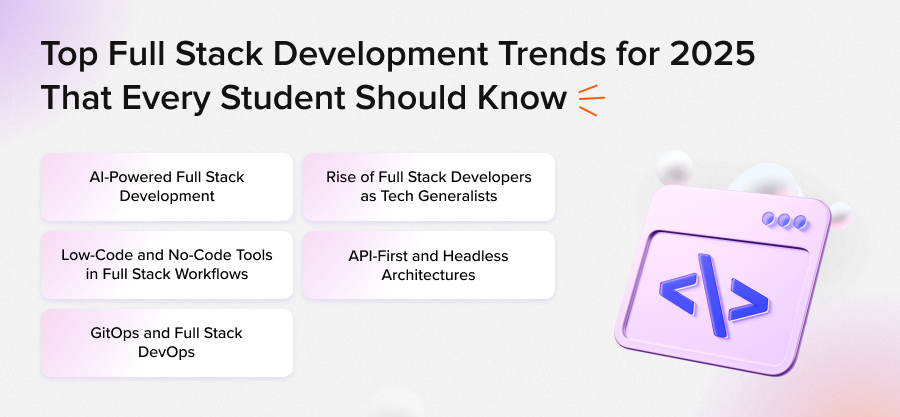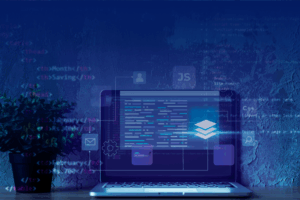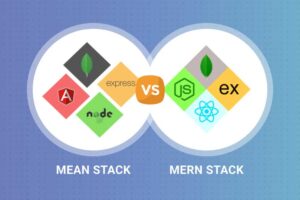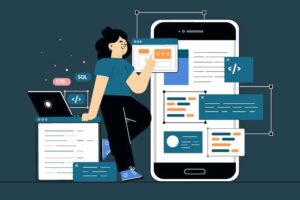Top Full Stack Development Trends for 2025 That Every Student Should Know

It’s time to break a common misconception: full stack development isn’t just about juggling front-end and back-end code anymore.
In 2025, full stack is becoming an all-rounder skillset that blends coding with business logic, DevOps with AI, and design thinking with deployment strategies.
Whether you’re building a personal project or preparing for a tech interview, the expectations from a full stack developer have grown beyond HTML, CSS, and a bit of JavaScript.
Hiring managers aren’t just looking for someone who can write APIs or design responsive UIs. They want adaptable, curious minds who can think like product owners and execute like engineers.
So, what’s reshaping full stack development in 2025?
And how can you, as a student, get ready for the shift?
Let’s explore the real full stack development trends that are redefining tech careers and how you can stay ahead.
Trend 1: AI-Powered Full Stack Development
Gone are the days when AI felt like a separate field. In 2025, AI is an essential part of a full stack developer's toolkit.
Tools like GitHub Copilot, ChatGPT, and Amazon CodeWhisperer are already revolutionizing how code is written, reviewed, and debugged. Imagine having a coding partner that can suggest functions, fix bugs, generate documentation, or even write test cases on the fly.
On the front end, AI is enabling personalized user experiences with smart UIs that adapt to user behavior. In the backend, AI-powered operations (AIOps) help with predictive load balancing, security threat detection, and database optimizations.
Why it matters for students:
Understanding how to collaborate with AI rather than compete with it will be a game-changer. If you’re in full stack development training, now’s the time to get comfortable with AI-assisted coding environments.
Trend 2: Rise of Full Stack Developers as Tech Generalists
In 2025, job titles are getting more fluid. Companies are hiring for roles like “Product Engineer,” “Full Stack AI Developer,” or “End-to-End Solution Architect.”
The reason?
Startups and even large enterprises want developers who understand the full picture from user need to final deployment. Being a generalist means having a broad understanding of each layer to effectively solve real-world problems.
Why it matters for students:
Instead of mastering only one language or framework, students need to build a strong foundation across the stack and back it with a product mindset. That’s what the future of full stack developers looks like.
Trend 3: Low-Code and No-Code Tools in Full Stack Workflows
Don’t let the “low-code” term fool you. These tools are not replacing developers; they’re making them faster.
Platforms like Bubble, Retool, Appsmith, and OutSystems let you quickly prototype admin dashboards, internal tools, or even integrate APIs, without writing 100s of lines of boilerplate code.
Why it matters for students:
Learning how to integrate no-code tools into full stack workflows can save time and impress recruiters. Projects built with speed and logic matter more than pure code length. No-code full stack workflows are already part of SkillStone’s full stack course modules, for good reason.
Trend 4: API-First and Headless Architectures
Traditional monolithic apps are giving way to modular, API-first architectures. This allows teams to build faster, scale smarter, and innovate without touching legacy systems.
Headless CMS platforms like Strapi and Sanity give developers total control over front-end experiences while keeping content management separate and secure.
Why it matters for students:
Understanding APIs, microservices, and headless frameworks will soon be basic expectations for full stack roles. Don’t just learn to fetch data, understand how APIs are designed, secured, and scaled.
Trend 5: GitOps and Full Stack DevOps
2025 full stack developers are not just coding apps; they’re deploying them too.
GitOps combines the power of Git with infrastructure automation. Tools like Docker, Kubernetes, and Terraform are now a staple for managing modern software environments.
Why it matters for students:
Employers expect developers to contribute beyond just writing code. Understanding CI/CD pipelines, containerization, and cloud infra makes you stand out. The SkillStone full stack course includes DevOps essentials for this very reason.
Bonus Trend: Quantum-Inspired Programming Models
While quantum computing isn’t mainstream yet, tech giants like IBM and Google are already experimenting with quantum-inspired algorithms that affect data processing and encryption.
Why it matters for students:
Being aware of concepts like quantum-safe cryptography and parallel processing will prepare you for advanced roles shortly. The future of full stack developers will include understanding more than just traditional logic gates.
Why Now is the Best Time to Upskill
The definition of a full stack developer is expanding rapidly. It now includes understanding AI tools, no-code platforms, API integrations, DevOps, and a clear product-thinking approach.
For students, this is an incredible opportunity. Why? Because you can build your foundation right the first time without having to unlearn outdated habits.
Whether you're just starting out or enhancing your SkillStone full stack course knowledge, keep your learning agile, project-driven, and future-ready.
Conclusion
Full stack development in 2025 is about more than mastering code; it’s about mastering context. The tools, trends, and technologies shaping the future are here to stay. Students who stay curious, embrace change, and build projects that blend multiple skills will lead the next wave of innovation.
Ready To Future-Proof Your Tech Career? Start Building The Stack That Goes Beyond Code.
FAQs
Q1. What are the top full stack development trends to learn in 2025?
AI-powered coding, low-code tools, API-first development, GitOps, and quantum-aware programming are among the top trends.
Q2. How is artificial intelligence changing full stack development?
AI tools like GitHub Copilot and ChatGPT assist in writing, testing, and debugging code. AI also powers smart UI experiences and backend optimizations.
Q3. Is learning low-code and no-code tools important for full stack developers?
Yes. These tools speed up development, especially for internal tools and prototypes, and are part of modern workflows.
Q4. What is the role of DevOps in modern full stack development?
stack developers are expected to understand containerization, cloud deployments, CI/CD pipelines, and GitOps practices.
Q5. Which programming languages and frameworks are most in demand for full stack developers in 2025?
JavaScript (React, Node.js), Python, TypeScript, and Go are in high demand, along with frameworks like Next.js and tools like Docker and Kubernetes.
Q6. How can students future-proof their careers in full stack development?
Stay curious, build real-world projects, explore SkillStone full stack courses, and focus on versatile, industry-relevant skills.
Q7. Is full stack development still a good career choice in 2025?
Absolutely. With businesses demanding end-to-end tech solutions, full stack remains one of the most dynamic and high-opportunity career paths in tech.
You may also like

The Future of Full Stack Development: Trends to Watch in 2025

MEAN Stack vs MERN Stack- Choosing the Right Stack To Learn in 2023

